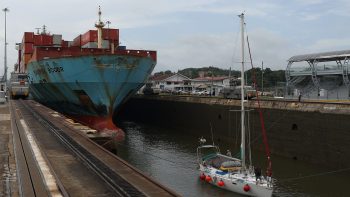Drought focuses Aussies on every drop
TEXT OF STORY
BOB MOON: This year has been anything but bountiful for drought-plagued farmers across the Southeast. In fact, much of the country has been coping with dry conditions, the Southwest U.S. as well, and as far north as Wisconsin. Federal disaster loans were recently made available to affected small businesses. Sadly, low water levels have become the new normal — and not just here. It’s a problem that’s a decade-old now in Australia, which happens to be the world’s most arid continent.
As Stuart Cohen reports from Sydney, there’s nothing like pocketbook pressure to focus the mind on conservation.
LAURELLE AND ANABELLE CARISTO: Yeah, it’s the washing. Can you say washing? Yeah, we’ll put the powder in there.
STUART COHEN: Laurelle Caristo, along with her one-and-a-half-year-old daughter, Anabelle and husband, Frank make sure no water in their household goes to waste.
LAURELLE CARISTO: That’s the washing machine grey water. We’ve got a, a grey hose that comes out into the garden and I just, we either put it on the grass or it goes into the bucket so we can put it on the plants. It’s just being water-wise, I guess. When your grass is brown from lack of rain, you know, just those little things like that can make a difference.
For Frank Caristo, like the rest of the more than four million people living in Sydney, the water shortage has meant giving up some things he took for granted just a couple years ago.
FRANK CARISTO: You can’t wash your cars with a hose. No long showers. You know, they came out with a whole list of songs that went for four minutes, actually so you could sing that song in the shower, then turn it off after that four minutes. They say make sure you don’t pick your favorite song as “Stairway to Heaven” as having a shower to, seriously.
The Caristos actually have it easy. To the north, in the state of Queensland, reservoirs have dropped to 15 percent of their normal capacity. Even filling a swimming pool requires a government permit.
DON BURKE: Australia is a, a land of horrendous droughts. I’m 60. It’s probably the worst in my lifetime.
Don Burke heads the Australian Environment Foundation. He says what Mother Nature made difficult, state governments have made desperate.
BURKE: Just looking out directly over where we’re sitting, a million people were moved in just over that ridge there. Now those million people should never have been moved in there. They basically didn’t provide them with any usable water and there was no water here for them.
Virtually every drop of Australia’s potable water comes from fresh rainfall into dams and reservoirs. Most of the wastewater then goes straight out into the ocean, instead of being piped back into the local water supply for re-use, like it is in the U.S. So no rainfall means no water to replenish the dams and reservoirs.
BERNARD CARLON: We’ve had to come to grips with a very multidisciplinary approach to securing our water supply into the future.
Bernard Carlon is with the New South Wales Department of Environment and Climate Change. He says governments are doing everything they can think of to save water. They’re spending millions to build desalination plants and water from all sources is jealously guarded. Habitual water-wasters face fines of more than $1,000, and the price of water climbs progressively higher for heavy users. But there are financial incentives, too.
CARLON: We’ve put in place, not only water restrictions, but we are providing incentives so you’re replacing your washing machine, you buy a water efficient washing machine, and we’ll give you a $200 rebate. For, you know, about $22 a plumber will come in and do a retrofit on your fittings.
One of Australia’s biggest success stories for water conservation has been the dual flush toilet. It has two buttons. A half flush, for when you just need to flush liquids, and a full flush for well, you know. Ross Young is director of the Water Services Association. He says this simple change is one of the ways Australians have cut their per capita water consumption by 25 percent over the last decade.
ROSS YOUNG: This is a very easy way of reducing water consumption without putting anyone to any effort, or without reducing people’s quality of life.
LAURELLE CARISTO: Frank, can you please put the bath, bath on for Anabelle?
Over the past couple months some welcome rain has finally started to fall in Australia’s parched regions, but for the Caristos, that relief won’t change their new conservation ethos.
LAURELLE CARISTO: It’s made us value water as a resource and, you know, we definitely won’t be going back to just leaving the tap running and wasting water.
Even Anabelle’s bath-time means getting creative with the cold water that first comes out of the tap. And when it’s all done, that bath water doesn’t just get thrown away. It waters the front garden.
LAURELLE CARISTO: Frank’s going to take the water out.
FRANK CARISTO: You want to chuck it out?
LAURELLE CARISTO:No, you take it out. Bye, bye water.
In Sydney, I’m Stuart Cohen for Marketplace.
There’s a lot happening in the world. Through it all, Marketplace is here for you.
You rely on Marketplace to break down the world’s events and tell you how it affects you in a fact-based, approachable way. We rely on your financial support to keep making that possible.
Your donation today powers the independent journalism that you rely on. For just $5/month, you can help sustain Marketplace so we can keep reporting on the things that matter to you.


















